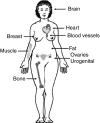The what, why and how of aromatase inhibitors: hormonal agents for treatment and prevention of breast cancer
- PMID: 17892469
- PMCID: PMC2228389
- DOI: 10.1111/j.1742-1241.2007.01587.x
The what, why and how of aromatase inhibitors: hormonal agents for treatment and prevention of breast cancer
Abstract
The third-generation aromatase inhibitors (AIs) anastrozole, exemestane and letrozole have largely replaced tamoxifen as the preferred treatment for hormone receptor - positive breast cancer in postmenopausal women. Approximately 185,000 new cases of invasive breast cancer are diagnosed yearly, and at least half of these women are both postmenopausal and eligible for adjuvant therapy with AIs. In addition, AIs are currently being tested as primary prevention therapy in large randomised trials involving tens of thousands of women at increased risk for breast cancer. Given the volume of use, internists will increasingly see postmenopausal women who are taking or considering treatment with AIs. Physicians need to be able to: (i) briefly discuss the pros and cons of using a selective estrogen receptor modulator such as tamoxifen or raloxifene vs. an AI for risk reduction and (ii) recognise and manage AI-associated adverse events. The primary purpose of this review is to help internists with these two tasks.
Figures



References
-
- Fabian CJ, Kimler BF. Selective estrogen-receptor modulators for primary prevention of breast cancer. J Clin Oncol. 2005;23:1644–55. - PubMed
-
- Simpson ER, Davis SR. Minireview: aromatase and the regulation of estrogen biosynthesis–some new perspectives. Endocrinology. 2001;142:4589–94. - PubMed
-
- Dowsett M, Stein RC, Mehta A, Coombes RC. Potency and selectivity of the non-steroidal aromatase inhibitor CGS 16949A in postmenopausal breast cancer patients. Clin Endocrinol (Oxf) 1990;32:623–34. - PubMed
-
- van der Wall E, Donker TH, de Frankrijker E, et al. Inhibition of the in vivo conversion of androstenedione to estrone by the aromatase inhibitor vorozole in healthy postmenopausal women. Cancer Res. 1993;53:4563–6. - PubMed
Publication types
MeSH terms
Substances
LinkOut - more resources
Full Text Sources
Other Literature Sources
Medical
Miscellaneous

